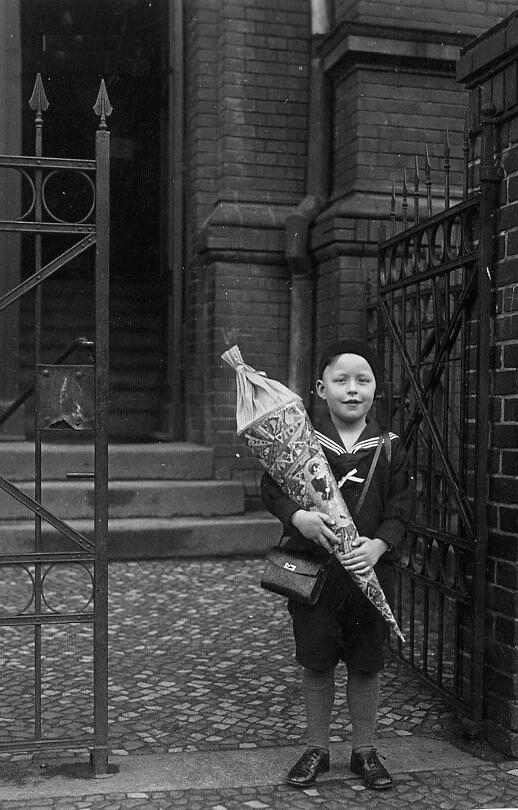
Figure 1.--Here we see a German boy on his first day of school, probably in the 1920s. The school looks rather forboding, but primary schools like this meant that city children, even younger students, could easily walk to school. |

|
Most German children wlked to school. Germany rapidly industrialized beginning in the mid-19th century and by the 20th century was an industrial powerhouse. As a result. the population rapidly urbanized. The primary children thus lived close to their schools and walked to school. The working-class largely lived in apartments and with a high density population schools could easily built within walking distance. There were also middle-class suburbs, but we believe most middle-class children also walked to school. We are less sure about secondary school students. A relatively small number of children continued on to secondary school until after World War II (1939-45). This mean the students often lived some distance from their schools, beyond walking distance. We think many students took public transport. Some may have also used bicycles. This was a middleclass option as few working-class childen had bicycles, but few working-class children atended secondary school. Very few children were driven to school. Automobile ownership was not widespread in Germany, ronically until after World war II. There was also a sizeable rural popultion. German industry was highly concetrated in western Germany--the Ruhr Valley in particular was heavily industrialized. Eastern Germany was much more rural. Schppls exisited in almot all villages so the children could walk to school. Children living on farms had more of a problem. Some had long walks. Ohers may have ridden ponnies to school. I'm not sure how common that was. Rural children were less likely to pursue secondary education. Those that did often boarded with relatives in towns and cities with secondary schools.
Most German children wlked to school. Germany rapidly industrialized beginning in the mid-19th century and by the 20th century was an industrial powerhouse. As a result. the population rapidly urbanized. The primary children thus lived close to their schools and walked to school. The working-class largely lived in apartments and with a high density population schools could easily built within walking distance. There were also middle-class suburbs, but we believe most middle-class children also walked to school. We are less sure about secondary school students. A relatively small number of children continued on to secondary school until after World War II (1939-45). This meant that the students often lived some distance from their schools, beyond walking distance. We think many students took public transport. Some may have also used bicycles. This was a middleclass option as few working-class childen had bicycles, but few working-class children atended secondary school. Very few children were driven to school. Automobile ownership was not widespread in Germany, ironically until after World war II. There was also a sizeable rural popultion. German industry was highly concetrated in western Germany--the Ruhr Valley in particular was heavily industrialized.
Eastern Germany was much more rural. And before World War II, the rural populaion while declining was still substantial. Germany had to import food to feed its large industrial work force. Even so, there was still a substantial rural poplation. Schools exisited in almot all villages so the children could walk to school. Children living on farms had more of a problem. Some had long walks. Ohers may have ridden ponnies to school. I'm not sure how common that was. The photographic record suggests that it was not very common. Farmers were often less sold on the value of education than people living in the city. This seems less the case today, but it was a definite pattern before World War II. Many farmers were more interested in the children helping out on the farm than pursuijg an education that waa likely to eventually take them off the farm. Rural children were less likely to pursue secondary education. Those that did often boarded with relatives in towns and cities with secondary schools.
Related Chronolgy Pages in the Boys' Historical Web Site
[Main Chronology Page]
[The 1880s]
[The 1890s]
[The 1900s]
[The 1910s]
[The 1920s]
[The 1930s]
[The 1940s]
[The 1950s]
[The 1960s]
[The 1970s]
[The 1980s]
[The 1990s]
[The 2000s]
Related Style Pages in the Boys' Historical Web Site
[Main school uniform page]
[Main country page]
[Long pants suits]
[Short pants suits]
[Socks]
[Eton suits]
[Jacket and trousers]
[Blazer
[School sandals]
Navigate the Boys' Historical Clothing School Uniform Pages
[Return to the Main coming and going to school]
[Return to the Main German school activities page]
[Return to the Main School Uniform Page]
[Australia]
[England]
[France]
[Germany]
[Italy]
[Japan]
[New Zealand]
[Scotland]
[United States]
Navigate the Boys' Historical Clothing Web Page
[Introduction]
[Activities]
[Biographies]
[Chronology]
[Clothing styles]
[Countries]
[Bibliographies]
[Contributions]
[FAQs]
[Glossaries]
[Images]
[Links]
[Registration]
[Tools]
[Boys' Clothing Home]
